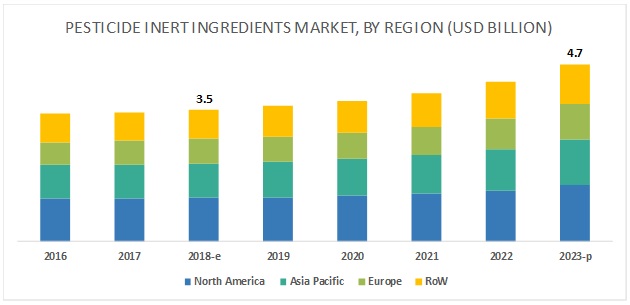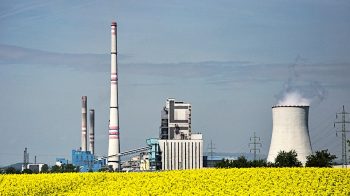The pesticide inert ingredient is added to the active ingredients to formulate the pesticide final product. When the inert ingredient is added to the formulation, it modifies the surface tension between pesticide spray drops and plant leaf surface to achieve better wetting, distribution, and penetration quality, resulting in an enhanced pesticide effect. The effectiveness of a pesticide increases manifolds with the addition of inert ingredients. The global market for pesticide inert ingredients is projected to grow at a steady rate, and the growth of the market is highly dependent on the requirement of crop protection products for improving the quality of crops. The pesticide inert ingredients market is projected to grow at CAGR of 6.14% from USD 3.5 billion in 2018 to 4.7 billion during the forecasted year of 2023.

The inert ingredients of a pesticide product potentially constitute up to 99% of the pesticide formulation and have been a confidential composition and therefore withheld by most of the pesticide manufacturers on their labels. According to the National Center for Biotechnology Information (NCBI), inert ingredients have been legally kept hidden from public view despite their toxic nature; the primary factor was to protect industry trade secrets. However, the US regulatory authority, Environmental Protection Agency (EPA) has been working toward policy changes, which requires 100% disclosure of a pesticide product’s ingredients. The major issue with pesticides and the inert ingredients is associated with its handling and environmental degradation, which in turn, gives rise to the development of major technologies such as microencapsulation. The advent of microcapsules as a type of inert ingredient results in better handling of toxic active ingredients and also controls the optimum release of pesticides. Technological advancements in inert ingredients for pesticide formulations are inevitable to succeed in the biological agrochemicals industry. This is projected to encourage the adoption of the microencapsulation technology in the crop protection industry, which has proven effects on the target. These factors are projected to impact the overall pesticide inert ingredients market with its rapid growth rate.
Download PDF Brochure:
https://www.marketsandmarkets.com/pdfdownloadNew.asp?id=176580687
The steady increase in market demand for organic fruits and vegetable has led to a gradual shift from synthetic products to bio-based products across the supply chain of the pesticide industry, which includes every constituent that is organically sourced. The pesticide products are made of active as well as inert ingredients. Thus, to make the products organic, it is required to formulate these with materials, which are non-toxic or mildly toxic in nature. There are many companies including AstroBio and Chem21, which are producing bio-based solvents such as bio-ethanol, limonene, and 2-methyl tetrahydrofuran (2-MeTHF) for their usage in various industries. This creates an opportunity for major players of agrochemical industries to develop bio-based inert ingredients and term the formulated pesticide appropriate for organic use and meet with the growing demand in the market.
On the basis of region, Asia Pacific is estimated to be the fastest growing market during the forecast period. Agriculture is one of the largest industries in the Asia Pacific region, with a large share of farmland and good soil fertility. Moreover, the region is rich in plant diversity due to the wide variations in climate across the countries. The Asia Pacific region is one of the leading consumers of pesticides across the globe, though the region heavily depends on imports for pesticide supply. Since inert ingredients are majorly consumed by pesticide manufacturers at the production facility during the formulation stage, and since countries such as India, Thailand, and Vietnam depend on imports for formulations, the market for inert ingredients is smaller compared to the Americas and Europe. However, with the increasing establishment of production plants in the Asian countries, the use of inert ingredients along with pesticide application would increase in the future.
Speak to Analyst:
https://www.marketsandmarkets.com/speaktoanalystNew.asp?id=176580687
Key companies in the market include BASF SE (Germany), DowDuPont (US), Royal Dutch Shell (Netherlands), Akzo Nobel N.V. (Netherlands), Stepan Company (US), Eastman Chemical Company (US), Croda International Plc (UK), Solvay (Belgium), Evonik Industries AG (Germany), Huntsman International LLC (US), Clariant (Switzerland), and LyondellBasell Industries N.V. (Netherlands). These companies offer chemical or specialty chemical products with wide industrial applications, which also include agriculture. They are focusing on constantly developing their products for the various industrial requirements. In addition, these companies are focusing on acquisitions, new product launches, and expansions to introduce novel products and increase their share in the market
